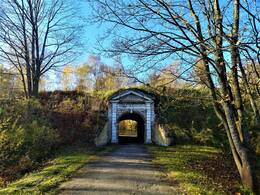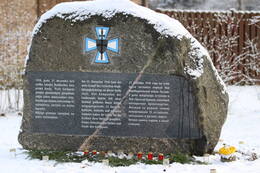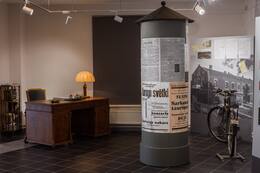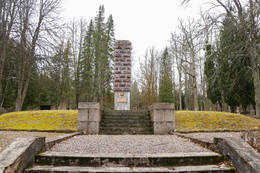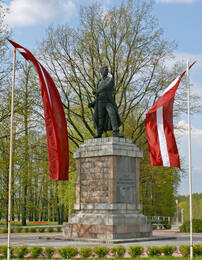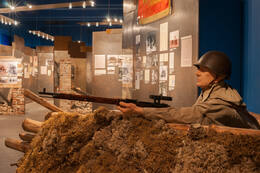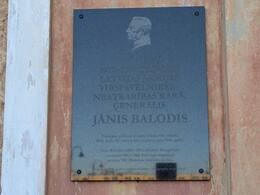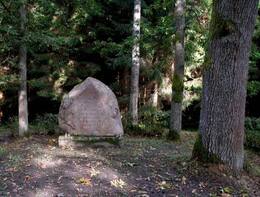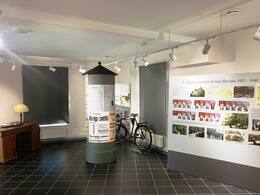Янис Балодис (1881-1965), главнокомандующий Латвийской армией, военный министр, генерал
I Первая мировая война, I Освободительные войны, II Вторая мировая война, IV Советская оккупация

Янис Балодис родился 20 февраля 1881 года в Вежениеках Трикатской волости. После окончания Трикатской приходской школы в 1898 году пошел добровольцем в русскую армию, служил в Камском 110-м пехотном полку в Каунасе. После окончания Вильнюсского юнкерского училища в 1902 г. Я. Балоди был произведён в подпорицы и зачислен в 100-й Островский пехотный полк. В 1905 году он принял участие в русско-японской войне, после чего продолжил службу в 106-м пехотном Уфимском полку в Вильнюсе.
Во время Первой мировой войны, в феврале 1915 года, капитан Янис Балоди был ранен под Гродно и попал в плен к немцам. После возвращения из плена Я. Балодис 1 декабря 1918 года добровольно вступил в ряды Вооруженных сил Временного правительства Латвии и стал командиром Офицерского резерва (впоследствии 1-й роты независимости). Участвовал в первых боях под Лиелауце, Скрундой и Вентой. 28 февраля 1919 года за военную службу произведен в батальон (подполковник). После смерти полковника Оскара Калпака Янис Балоди был назначен командиром 1-го латышского отдельного батальона (позже бригады), а вскоре после этого, 21 марта 1919 года, ему было присвоено звание полковника.
После Цесисских сражений, когда 6 июля 1919 года Северолатышская бригада вошла в Ригу и две группы объединились в одну национальную армию, Балодис был назначен командиром только что созданной 1-й Курземской дивизии и, таким образом, также командиром латышских воинских частей на Восточный фронт. В этой должности он проводил наступательные операции в Латгалии. 16 октября 1919 года назначен главнокомандующим Латвийской армией. Под руководством Яниса Балоза небольшая армия Латвии при поддержке соседних стран уничтожила и изгнала бермонтовцев, затем в 1920 г. вначале разгромил большевиков в Латгалии. 23 января 1920 года ему было присвоено звание генерала. В марте 1921 года Балодис был отправлен в отставку в связи с его ликвидацией и переходом армии на мирное время. 1 июля 1921 года уволен из армии по собственному желанию. После окончания военной карьеры генерал Ю. Балодис занялся политикой, став депутатом Сейма Латвийской Республики с 1925 по 1934 год. 26 октября 1925 года он был назначен членом Совета военного ордена Лачплесиса.
Янис Балодис награжден всеми тремя степенями Военного ордена Лачплесиса, а также многими иностранными наградами. За заслуги на благо государства награжден хутором Баложи (ранее Упесмуйжа) в Ливберзской волости.
7 декабря 1931 г. военным министром был назначен Я. Балодис. Принимал активное участие в государственном перевороте Карлиса Улманиса 15 мая 1934 года. В соответствии с законом от 12 марта 1936 года Балодис назначался президентом в случаях, предусмотренных законом.
Во время советской оккупации в июле 1940 года был задержан и выслан с женой в Сызрань, где проживал под надзором органов безопасности. В 1941 году, во время начала Великой Отечественной войны, Балодис был арестован и помещен в Куйбышевскую тюрьму. В 1946 году его перевели в Ивановскую тюрьму, а в марте 1952 года отправили во Владимирскую тюрьму.
Янис Балодис вышел из тюрьмы в 1956 году и вместе с женой вернулся в Латвию. Жил в Саулкрасты, где и умер 8 августа 1965 года. Похоронен в Риге на I Лесном кладбище.
Дополнительные источники информации
Эрик Джейкобсон. Янис Балодис. - Национальная энциклопедия: https://enciklopedija.lv/skirklis/29969-J%C4%81nis-Balodis
Янис Балодис. Блокноты памяти. 1918-1939 гг. год, комп. А. Цауне, издательство Института истории Латвии, Рига, 2015.
Андрис Каун. Генерал Янис Балодис в русской ссылке и тюрьме, 1940–1960 гг., Издательство Латвийского института истории, Рига, 2016.
Последние годы жизни генерала Яниса Балоза в Латвии, 1956–1965 гг., Воспоминания и свидетельства современников, сост. А. Цауне, Рига, изд-во Латвийского института истории, 2014.
Биография Яниса Балозиса, кавалера Военного ордена Лачплесиса: http://lkok.com/detail1.asp?ID=2141
Связанная хронология
Связанные объекты
Мемориальные места генералам и рыцарям Военного ордена Лачплесиса в Трикатской волости
Памятная стела находится рядом с часовней Трикатского кладбища.
Трикатское кладбище хранит память о трех выдающихся латвийских полководцах – Робертсе Дамбитисе, Карлисе Гопперсе и Янисе Балодисе. На Трикатском кладбище похоронен Екаб Мурниекс, учитель всех этих генералов.
Память генералов и кавалеров Военного ордена Лачплесиса ежегодно отмечается факельным шествием на Трикатское кладбище, где установлены две мемориальные скульптуры, на которых выгравированы имена 17 кавалеров Военного ордена Лачплесиса, связанных с Трикатской волостью.
Стела была открыта 11 ноября 2018 года.
Видеорассказ о военном ордене Лачплесиса и наборе орденов генерала Яниса Балодиса.
Даугавгривская (Daugavgrīvas) крепость
Даугавгривская крепость находится на острове Даугавгрива в устье реки Бульупе в Даугаве, вход с улицы Бирзес. Крепость была построена в 17-м веке для защиты от врага направления на административный, торговый и промышленный центр – Ригу. Позже крепость стала главным укреплением береговой обороны Латвийской армии с несколькими опорными пунктами. Оборонительные укрепления и их система являются одними из самых ценных объектов военного наследия Латвии. Крепость - яркий свидетель военной истории Латвии. Например, во время Крымской войны (1853-1856 гг.) латышские и эстонские команды пушечных кораблей обучались в Даугавгривских укреплениях. Это были боевые части для защиты местных портов и побережья от атак британского военного флота. Во время Первой мировой войны здесь формировались Даугавгривские роты земессардзе - первые латвийские боевые подразделения, еще до латышских стрелков. В наши дни вы можете осмотреть территорию крепости. Рядом находится Приморский природный парк Кометфортс, а на другом берегу Даугавы - укрепления Мангальсала.
Памятник первой битве за независимость Латвии
Атроадас, Инчукалнс, улица Атмодас 2.
3 июля 2016 года был открыт памятник первой битве за независимость Латвии, посвященный Латвийской национальной гвардии (Die Lettländische Landeswehr). Эйженс Упманис, председатель комитета Братского кладбища, пришел к выводу, что это может быть исторически первый памятник объединенным латвийским и балтийским силам в боевых мемориалах за пределами кладбища. В то время подполковник Оскарс Калпакс был назначен командиром латышских частей Латвийской национальной гвардии или Ландесвера, из частей которой позже выросла и сформировалась латышская армия во время Борьбы за свободу.
В 1918 году вся территория современной Латвии попала в руки Германской империи и ее войск. Однако в конце лета-осени 1918 года ситуация стала для Германии плохо кончаться, и стало ясно, что вынужденная констатация поражения Германии в Первой мировой войне — лишь вопрос времени. Российская империя, в состав которой входила Латвия до Первой мировой войны, прекратила свое существование раньше, с революциями февраля и октября 1917 года. 18 ноября 1918 года была провозглашена Латвийская Республика. После прекращения огня с Антантой 11 ноября 1918 года немецкая армия, находившаяся на территории Латвии, уже не была мотивирована на дальнейшие боевые действия, и большинство ее солдат просто хотели вернуться домой.
При таких обстоятельствах было ясно, что оборона Латвии зависела в первую очередь от национальной гвардии, сформированной латвийцами. Первоначально в силу своей образованности и сравнительно большей способности к самоорганизации наибольшую инициативу в создании такой национальной гвардии проявляли жившие в Латвии балтийские немцы. Российские солдаты также присоединились к Национальной гвардии. Для обеспечения снабжения Национальной гвардии обмундированием, оружием и другими необходимыми средствами, 7 декабря 1918 года Временное правительство Латвии заключило договор с немецким представителем Августом Виннигом, предусматривавший обеспечение Национальной гвардии из резервы немецкой армии в Латвии. В этом соглашении, среди прочего, указывалось, что Национальная гвардия, официально известная как Латвийская национальная гвардия или по-немецки die Lettländische Landeswehr, будет вооруженными силами Латвийской Республики.
Перед Латвийской национальной гвардией столкнулись два солдата Латвийского Красного стрелкового полка (т.е. примерно 2000-3000 солдат), ранее прошедшие Первую мировую войну и Гражданскую войну в России. Несмотря на опыт и численное превосходство Красной Армии, Латвийская национальная гвардия два дня удерживала Инчукалнс в ожесточенных боях, пока, наконец, вечером 1 января 1919 года, чтобы избежать осады, не была вынуждена отступить, потеряв 43 человека убитыми и несколько человек. раненых, большинство из которых попало в плен к большевикам, где были убиты или умерли от голода или болезней.
Автор: Артис Букс. Материал: Валун. Памятник изготовлен из крупного монолитного камня, который был найден в Роллс недалеко от Елгавы.
Экспозиция «Латвийская армия в Плявинясе в 20 веке»
Адрес: улица Одзиенас 2, Плявиняс.
Можно увидеть постоянную экспозицию «Латвийская армия в Плявинясе в 20 веке».
Здание в Плявинясе, улица Одзиенас 2, имеет долгую историю – с того времени, когда в нем начал активную хозяйственную деятельность торговец Stukmaņi Хуго Апелтофтс, тем самым способствуя развитию города Плявиняс, до того момента, как здесь во время Война за независимость. В 1919 году действиями частей Латвийской армии против Красной Армии в Латгалии командовал непосредственно Плявиняс.
В 1934 году возле этого дома была открыта мемориальная доска с надписью: «В 1919 году в этом доме располагался штаб Восточного фронта, и здесь генерал Янис Балодис принял командование Латвийской национальной армией». Он был снят и разрушен советской властью в 1940 году, но 16 июня 1990 года при поддержке отделения LNNK в Плавинасе восстановлен.
Теперь рядом со зданием бывшего штаба стоит мемориальный киоск, посвященный 15 кавалеристам Военного ордена Лачплесиса, родившимся в Плявиньском районе, а также дающий представление об истории жизни рыцарей Военного ордена Лачплесиса.
Недалеко от экспозиционного здания находится штаб-квартира Латгальского отдела, построенная в 1913 году графом Теодорсом Медемсом как завод по производству ликеров Stukmaņi. В 1919 г. он был захвачен режимом П. Стучки, где также была устроена тюрьма. После изгнания большевиков в 1925 году здание перешло к Латвийской армии, где располагался штаб Латгальской дивизии. В этом здании 10 генералов и других офицеров латвийской армии провели свою военную карьеру. В 1940 году здание было передано Красной Армии. В послевоенные годы здесь располагалась школа и муниципалитет. Около 1970 года здание начало использовать производственное объединение «Rīgas Apīrsbs».
Посещение выставки необходимо бронировать заранее по телефону 28442692.
Памятник членам прихода Тирза, павшим в войне за независимость
Находится на кладбище Тирза.
Виден памятник с головой льва.
Памятник из битого валуна по заказу архитектора Александра Бирзениекиса и скульптора Вильгельма Трейса по заказу Тирзинского отделения Братского кладбищенского комитета. Памятник построил кузнец Блумбергс. Памятник изготовлен на средства, пожертвованные членами Тирзинского прихода и Братского кладбищенского комитета. В фонд памятника было пожертвовано 2377 латов. Открыт 9 сентября 1928 года.
Памятник выполнен из массивных гранитных блоков в виде прямоугольной колонны и производит впечатление символа силы и независимости. Бронзовые части и украшения памятника были созданы скульптором Вильгельмом Трейсом. Материал: гранит, бронза, форма: архитектурная композиция с медной ковкой. С одной стороны памятника находится бронзовая голова льва и табличка с надписью: «В этом святом месте добродетель великих людей создала долгий дом». На другой стороне написано: «На вечную память сыновьям общины Фирца, павшим на войне и в войне за независимость. Год 1928».
Известно, что на церемонии открытия памятника 9 сентября 1928 года его освятил архиепископ Эдгар Берг. На церемонии открытия также присутствовал легендарный генерал Янис Балодис, выдающаяся личность в истории Латвии. Он был главнокомандующим армией в боях против бермонтцев и Красной Армии в Латгалии. После переворота 1934 года он был вторым человеком в стране и оставался им после 1940 года.
В 2008 году с помощью Общества развития «Тирза» памятник был отреставрирован.
Памятник павшим воинам Латгальского партизанского полка 1919 - 1920 гг.
Памятник Латгальскому партизанскому полку.
В истории Войны за независимость Латвии (1919-1920) Латгальский партизанский полк, колыбель которого когда-то находилась на территории бывшего Балвского района, был сформирован из «зеленых» полков уже в конце 1918 года.
Памятник был впервые открыт 14 августа 1938 года при участии генерала Яниса Балодиса. Автор памятника – художник Карлис Янсонс.
В 1940 году коммунисты разрушили памятник, после установления советской власти исполком Абренского района весной 1941 года принял решение о сносе памятника, но изображение партизана было захоронено во дворе Балвского ополчения. В немецкое время памятник восстановили, но когда вернулась Красная Армия, памятник второй раз снесли, вывезли и уничтожили. Когда Латвия восстановила свою национальную независимость, жители Балвен собирали пожертвования на восстановление памятника латгальским партизанам. 11 ноября 1993 года в Балвосе был открыт отреставрированный памятник Андрею Янсонсу, сыну художника Карлиса Янсонса.
Военный музей Латвии
Военный музей Латвии находится в Старой Риге, недалеко от Памятника Свободы, в Пороховой башне - старинном оборонительном сооружении. В музее 11 экспозиций. На выставке представлено различное оружие, документы, униформа, награды и другие предметы, относящиеся к войне и повседневной жизни солдат. Военный музей Латвии - один из старейших музеев Латвии. Его история началась во время Первой мировой войны. Коллекция музея создана в основном из предметов с полей сражений и личных вещей солдат. После создания Латвийского государства основной целью музея стало создание экспозиции о военной истории Латвии и активной роли ее жителей в защите своей земли.
В 1937 году музей был расширен за счет пристройки и технически был одним из самых современных музеев того времени в Европе. Пороховая башня - одна из бывших крепостных башен Риги. Упоминается в 1330 году как Песчаная башня. В 1621 году, когда Рига была окружена шведскими войсками, башня была разрушена. В 1650 году была построена новая башня для хранения пороха и оружия. После сноса городских укреплений Пороховая башня - одно из самых ценных свидетельств оборонительной системы Риги.
Мемориальная доска, посвященная главнокомандующему Латвийской армии Янису Балодису.
Он расположен в Даугавпилсской крепости, на стене здания, перед парковкой.
Мемориальная доска сообщает, что в этом доме (на улице Официеру находились дома офицеров) жил главнокомандующий Латвийской армии во время войны за независимость генерал Янис Балодис (1881-1965). Мемориальная доска со следующим текстом была открыта в межвоенный период – 29 сентября 1936 года, когда в Даугавпилсской крепости располагалась латвийская армия.
Его сняли после 1940 года, но в 2020 году его снова установило объединение «Даугавпилс мантоюмс».
Мемориальный камень на месте боя бригады генерала Яниса Баложа
Мемориальный камень на месте боя бригады генерала Яниса Баложа находится в лесу недалеко от шоссе Рига-Лиепая (А9), недалеко от дома Батару.
Мемориальный камень был открыт в 1936 году с торжественной церемонией, на которой присутствовали министр сообщения Б. Эйнберг и другие высокопоставленные чиновники Риги и общины Джукстского прихода в 1936 году, в память о битве, произошедшей здесь 22 марта 1919 года. На памятнике имеется надпись: «22 марта 1919 года произошел бой 1-й Балозской бригады, в котором 10 солдат были убиты и 28 ранены».
Бой произошел между Отдельной латышской бригадой и 10-м советским латышским стрелковым полком, состоявшим на 90 процентов из латышей. Во время освободительной борьбы это была одна из тех битв, в которых латыш сражался против латыша. Вельможи обосновались в домах батаров. Они открыли огонь по солдатам бригады, шедшим в сторону Калнциемса. Когда огонь усилился, бригада перешла в бой. Основной удар в бою приняли на себя Отдельная студенческая рота и Латвийский батальон независимости. В ходе боя взвод студенческой роты и вновь сформированной роты капитана Э. Граудиняса, выполняя обходной маневр, столкнулись в лесу с противником, совершившим аналогичный маневр. В ожесточенном бою, местами перешедшем в рукопашную схватку, противник был повержен. В это время приданная бригаде немецкая батарея Миллера открыла огонь по домам батаров. После артиллерийского огня бригада стремительной атакой выбила противника с позиций.
Газета «Брива Земе» (18.05.1936) опубликовала воспоминания бывшего бойца: «Едва всадники бригады выехали на открытое место, как их встретил сильный огонь противника. После этого было видно, что мы имеем дело с очень сильными силами противника. По приказу генерала Я. Баложи батальоны развернулись и начали бой, вступив в ближний бой, поскольку штыки солдат бригады разрешили этот двухчасовой бой в блестящую победу калпакцев. Это сражение имело большое значение, поскольку оно выровняло положение фронта, ставшего небезопасным из-за немцев, и обеспечило отсутствие выхода красных стрелков на Земгальскую равнину».
Бригада генерала Я. Баложи выиграла сражение, потеряв 10 солдат, в том числе Карла Барона (1900.8.III – 1919.22.III), внука отца Дайну Кришьяниса Баронаса, похороненного на Рижском братском кладбище. В бою погибли 50 солдат советского Латышского стрелкового полка.
Выставка «Латвийская армия в Плявинясе в ХХ веке»
В экспозиции размещены информационные стенды с историческими фотографиями, картами и информацией о создании штаба Восточного фронта Латвии. Композицию выставки составляют элементы интерьера, соответствующие историческим событиям.
Выставка «Латвийская армия в Плявиньше в ХХ веке» расположена в Плявиньше, улица Одзиенас, 2, в историческом здании, где в июле 1919 года во время Освободительной войны располагался штаб Латвийского Восточного фронта. Двухэтажное здание прямоугольной формы с двускатной крышей, здание построено из красного кирпича. Сегодня от первоначального фасада сохранился второй этаж здания с видимыми эркерами окон. В настоящее время фасад первого этажа здания оштукатурен и покрашен, старые оконные эркеры расширены, витрины магазина «Лат» застеклены. На втором этаже в оконных эркерах вместо исторических деревянных окон установлены пластиковые окна.
Здание имеет долгую историю – с тех пор, как оптовый торговец «Стукмани» Хуго Апелтофтс начал в нем активную хозяйственную деятельность, способствуя тем самым развитию города Плявини.
В 1934 году была установлена памятная доска с надписью: «В 1919 году в этом доме располагался штаб Восточного фронта, и здесь генерал Янис Балодис принял на себя верховное командование Латвийской национальной армией». Он был снят и разрушен советскими властями в 1940 году, но 16 июня 1990 года восстановлен при поддержке отделения ЛННК Плявиню.
Сейчас возле здания бывшего штаба стоит памятная стела, посвященная 15 кавалерам Военного ордена Лачплеша, родившимся в Плявиньском уезде. После изгнания большевиков в 1925 году здание перешло в руки Латвийской армии, в которой располагался штаб Латгалии. Разделение. В этом здании провели свою военную карьеру 10 генералов и других офицеров латвийской армии. В 1940 году здание перешло в руки Красной Армии. В послевоенные годы здесь располагалась школа и муниципалитет. Примерно в 1970-х годах здание использовалось производственным объединением «Ригас Апрекупс».
Посещение выставки необходимо бронировать заранее по тел. +371 28442692.
Связанные истории
Жизнь генерала Яниса Балоша после возвращения из депортации
Когда русские пытались навязать латвийскому правительству соглашение о военной базе в 1940 году, что сделало бы почти невозможным сопротивление латвийской армии Красной Армии, генерал Я. Балодис пытается добиться некоторых поправок к этому соглашению. Но это не удается. Но плохие парни генерала используют это обстоятельство, чтобы потом поправить Дж. Балоди чуть ли не как предателя. После конфликта с премьер-министром государства и премьер-министром К. Улманисом 5 апреля 1940 г. генерал был освобожден от должности военного министра. Затем Я. Балодис решает участвовать в выборах в Сейм от Демократического блока, но из этого ничего не выходит, потому что на выборах может баллотироваться только один список - список кандидатов от коммунистов. Латвия становится 14-й советской республикой.
Памяти Оскарса Калпака
Память об Оскарсе Калпаке хранится во многих местах - о чем свидетельствуют его родные дома в Лиепсалу, памятник на кладбище Висагала, памятные мероприятия и прекрасные концерты 6 марта, начальная школа калпаков Мейранских калпаков, улицы в Лубане, Мадоне и других городах и многое другое. Но в этой статье - о сохранении памяти Оскара Калпака в его родной половине 20-30 веков. годы.
Начало, ход и конец битв при Цесисе
Победа в битвах под Цесисом должна была стать поворотным моментом в борьбе латышей и эстонцев за независимость своей страны. Эта победа пересекла черту между правительством Андриева Ниедра и планами немецкого генерала Ридигера фон дер Гольца по завоеванию Прибалтики. Вместо этого Временное правительство Карлиса Улманиса возобновило свою деятельность в Лиепае.
Памяти Петериса Радзиньша, генерала Латвийской армии, двукратного кавалера Лачплесского военного ордена
Генерал Петерис Радзиньш родился в Лугской волости Валкского района в простой крестьянской семье, где и научился работать в поле. Он был очень умным молодым человеком, окончив школу, он принял решение в пользу войны, и она начала свое армейское спасение Латвии от войск Бермонта. П. Радзиньш был одним из самых выдающихся офицеров Латвийской армии и был награжден многочисленными латвийскими и иностранными орденами и памятниками.
О церемонии открытия Судрабкалниньша
Отрывок из обращения генерала Яниса Балоша в день открытия памятника Судрабкалниньшу. Полный текст содержит речи открытия, выступления президента Латвии Карлиса Улманиса и генерала Яниса Балоша. Воспоминания были выбраны потому, что они четко показывают состояние боевых действий латвийской армии в окрестностях Судрабкалниньша.
Бомб Хилл
Холм Бумбу - высокий холм в дюнах Болдерая, в лесу Клейсту, Рига. Мемориал латвийских боев за свободу. Во время Бермонтиады в ноябре 1919 года здесь находился командный пункт Латгальской дивизии под руководством Кришьяниса Беркиса. 6-й Рижский пехотный полк, наступая с холма Бумбу, овладел Судрабкалницей. Мемориальная доска была установлена в 1939 году и разрушена в 1969 году. Мемориальный комплекс был восстановлен в 1989 году.
За менее известные работы латвийского скульптора Карлиса Зале на старых кладбищах Дивалс и Триката.
Одной из малоизвестных работ скульптора Карлиса Зале (1888-1942) является скульптура из известняка «Розы-розы», созданная между 1939 и 1940 годами и связанная с созданием ансамбля Братского кладбища.









